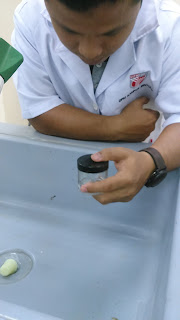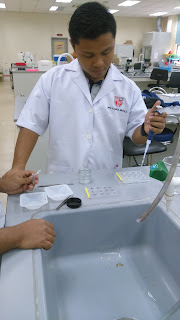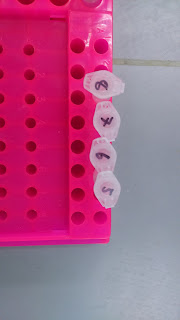Propagation of Seagrass ( Thlassia hemprichii ) in Artificial Seawater
Introduction
The samples were taken at Teluk Pelanduk and Teluk Keamang, Port Dickson, Negeri Sembilan. Each group have chosen one species of seagrass for their group. Our group species is Thlassia hemprichii The samples then were taken to laboratory with their originate substrate for culture.
Materials
Samples (nama species), aquarium, basket, white cloth, tooth pick, air stone and filtered seawater
Methodology
1. Fill a aquarium with filtered seawater.
2. A white cloth been placed on the bottom of the basket, then placed the substrate on the white cloth.
3. Thlassia hemprichii were planted in the basket with tooth pick is placed on each node of the samples and air stones are fixed to maintain circulation in the aquarium.
4. Aquarium is placed near the window for sunlight.
5. Samples were observed weekly for their growth.
Trip to Teluk Kemang and KOMASS
Seagrass is a marine angiosperm which belonging to four
plant families which is Posidoniacea, Zosteraceae, Hydrocharitaceae and
Cymodoceaceae. The function of seagrass to surrounding is, act as a food
sources for fish and humans, as a nest
for a fish to lay their eggs, keep the
water clean, gives oxygen to surrounding and many more. Not only seagrass
attached on the soil or mud, they also attached on the rope, rock an dother
shell of invertebrate organisms. There is a big differences between seagrass
and seaweed. The differences is in the following table :
Seagrass
|
Seaweed
|
Prostrate
stem or extensive rhizomes
|
Prostrate
axis or stolon, rarely extensive
|
Buried
in the substrate
|
Above
the substrate
|
Stem
bearing leaves
|
Rachis
bearing thallus
|
Leaves
generally green
|
Thallus
can be red, brown and green
|
Produce
flowers, fruits and seeds
|
Produce
sporangium and spores
|
In Malaysia, seagrass can be found in
many places especially in Teluk Kemang, Merambong shoal and other places .
Seagrass culture already exist a few years ago. Some species is easy to culture
which doesn’t need frequent checking on them and some species is hard to culture
which need to check it frequently to make sure it growth in healthy. There is a
technique to culture these aquatic plants.
Today we’re going to the place which had high diversity of
seagrasses which is Teluk Kemang to collected some samples to culture for each group. The
instruction is each group must collect
different type of seagrass to culture in the laboratory. After we arrive , we
being giving a briefing about our activities today.
There are many types of species of seagrass
that we found ar Teluk Kemang which is Halodule
sp. , Halophila ovalis, Halophila becarii, Halophila spinulosa, Thalassia
hemprecii, Gracilaria sp. , Sargassum sp. , Padina minor, Caulerpa racemosa,
Cymodocea rotundata, Cymodocea serrulata and many more seagrass species in
Teluk Kemang.
Besides collecting samples, we also must
observe the ecology or diversity of the seagrass in that place. During our
activities, our group had found some crabs and fish species in seagrasses area.
This had approve that, the diversity of seagrass not only give the benefits to
the plant itself also give other organisms benefit for their survivor.
Picture
1 : The collecting sample area in Teluk Kemang
Picture 2 : One of our member group collecting the seagrass sample
Picture 3 : Species that we selected for culture ( Thlassia hempricii)
Picture 4 : Putting some seagrass into aquarium tank.
Picture 5 : The pufferfish that had being found among seagrass (Line black and yellow)
After we’re done
collecting samples in Teluk Kemang, our next destination is to KOMASS. In this
place, we being asked to determine the domain species of aquatic plants that we found in that
area. The domain species is Sargassum sp.
What we learn from
our trip is we manage to observe the abundance of variety of seagrass and seaweed
; also we observe the life form of
seaweeds at the different region.For an example, some red seaweed like Gracillaria sp. attached to other aquatic plant or on the rock . Besides that, we also learn how
to culture the seagrass in aquarium by determine the number of nodes for each weeks.




























